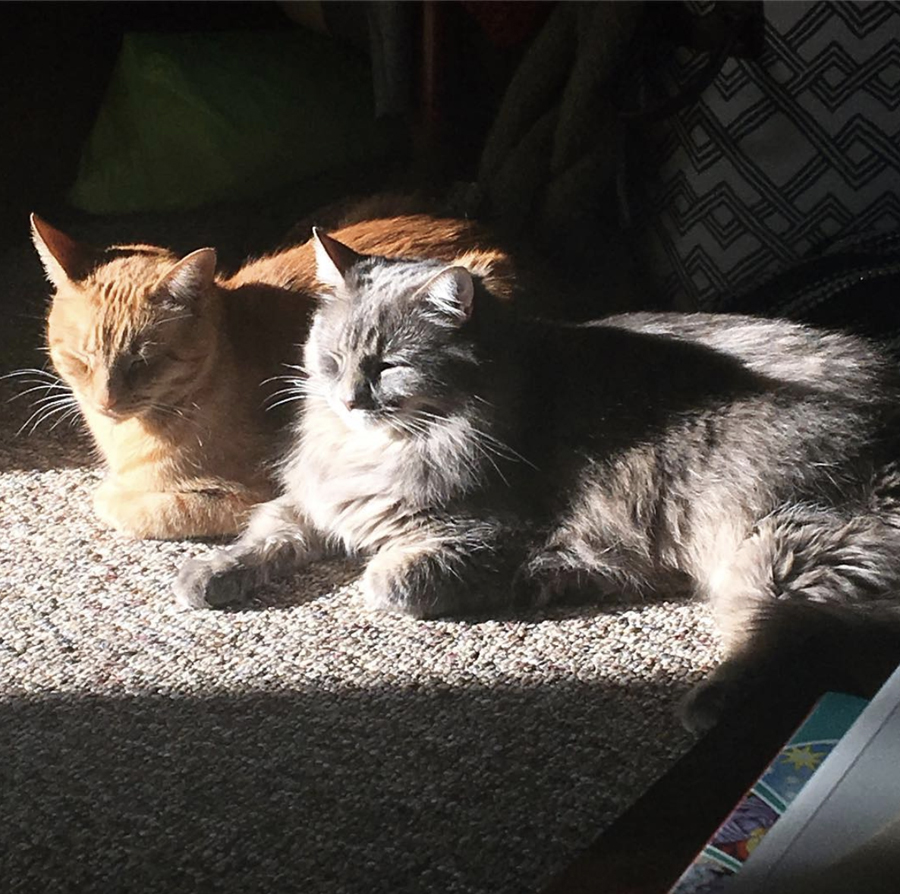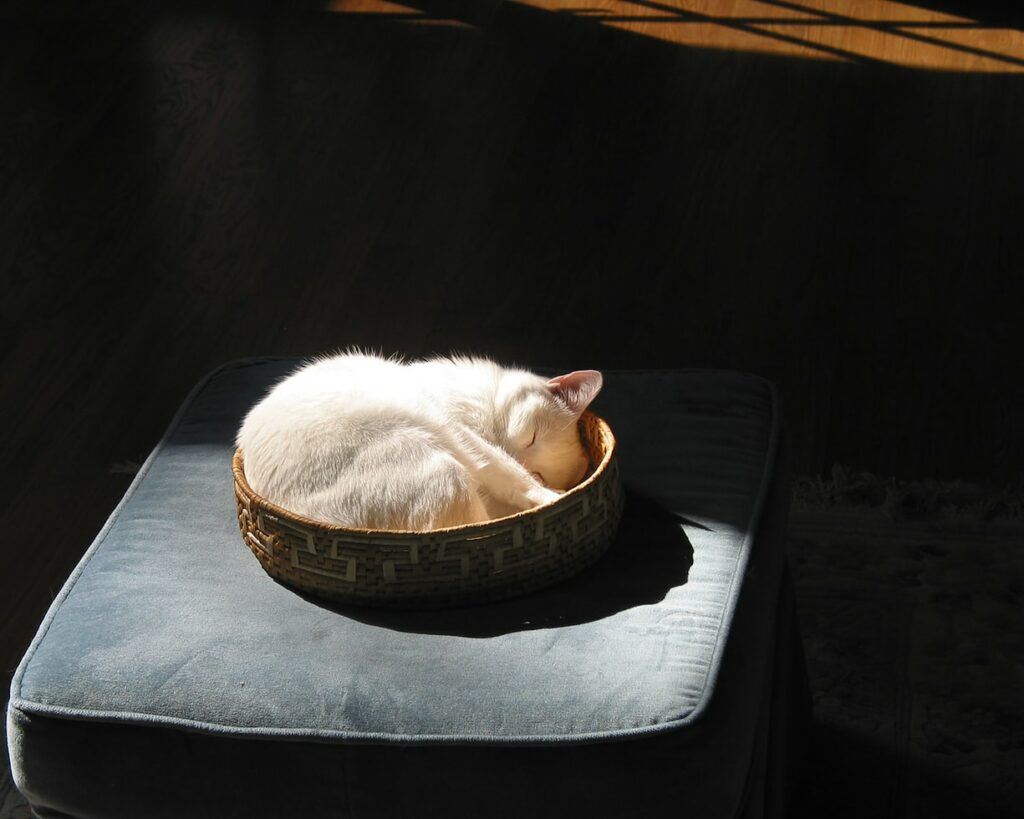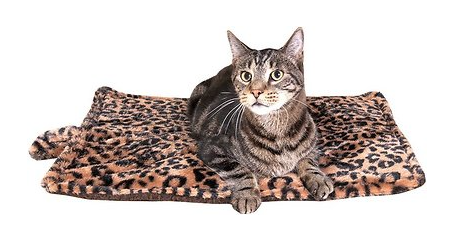This post may contain affiliate links. This means I may receive a small commission if products are purchased through them. All opinions are honest and remain my own.
Chances are, you’ve caught your cat basking in the afternoon sunbeams. But just why do cats like to lay in the sun so much?
Cats lay in the sun to conserve energy and stay warm. Since their normal body temperature runs between 101 – 102.5 degrees Fahrenheit, they need to keep warmer than humans. Laying in the sun is an easy, energy-conserving way for them to maintain their higher body temperature while they sleep.

Cats LOVE warmth
Cats are warmth-seeking little furballs.
Each cat will have its own favorite spot to seek heat. One of my cats from childhood, her favorite spot was on top of the fridge. Another cat I had absolutely loved to cuddle up next to you underneath a blanket. My current cat Louie’s favorite spot is on the heat register.
However the one thing they all had in common was they LOVED any spot with sunshine.
They also love to conserve their energy
Cats are all about energy conservation and spend a large portion of the day snoozing or resting their eyes. It’s not that they’re lazy, but they’re resting up for their next hunt. Cats still have these biological impulses, even if they’re not actually needing to hunt for any food.
Maintaining body temperature is something that expends energy. In the case of cats, their normal body temperature can run anywhere from 101 or 102.5 degrees Fahrenheit (38.3 – 39.2 degrees Celsius). This is a few degrees higher than ours, and it takes more work to keep it up.
When a cat sleeps, they experience a slight drop in body temperature.
So laying in sunlight helps cats maintain their core body temperature a lot more easily while snoozing – therefore, conserving energy and being prepared for their next “hunt” – even if it is just chasing after a cat toy or some random object on the floor!
But can cats get too hot in the sun? Will they overheat?
Hyperthermia – which happens if a cat’s core body temperature reaches 105 degrees – is a real threat. Cats that are trapped in hot cars or garages in high temperatures are at risk for this and can most definitely develop heatstroke.
However, cats with access to fresh water and cool spots (any type of shade) will fair pretty well in the heat.
When it comes to overheating, cats are pretty smart.
If a cat is actually too hot, it won’t be laying in sunbeams. But what you perceive to be too hot and what your cat does may be very different! Cats seem to like warm temperatures.
On really hot days, cats will lay in cool spots like hard floors and tile or in the shade. I notice my cat will lay on the hard floor during summer heatwaves, something he would never do otherwise.
If you’re concerned about your cat being too warm in your home, keep a cool fan running for them to lay in if they please. You can also crack a window at night to give them some fresh cool breeze.
Also check out: 40 Crazy Cat Facts for Kids
Can cats get sunburned? What about through windows?
It’s totally possible for cats to get sunburned and even develop solar dermatitis – a progressive skin disease that can lead to cancer. This can happen through windows as well since they don’t filter out all the harmful UV rays, but it’s unlikely unless your cat is particularly sun sensitive.

Cats that are all white and hairless cats are most at risk for this to actually happen. However, it doesn’t exclude cats that are black and white, orange and white, calicos, etc. Any cat that doesn’t have an all-dark coat is more susceptible because its fur does not protect them as much.
This is also obviously a much greater risk for outdoor cats. If you have a cat that goes outdoors, make sure they have nice shady spots to hide out in.
Do cats absorb Vitamin D from the sun?
Even though cats may get some vitamin D from licking their fur after exposing themselves to some sun, research shows that the sun is not the main source of Vitamin D for cats. They mostly need to obtain this nutrient from their diet.
This 1999 study from the American Society Journal of Nutrition looked into this subject and discovered if cats are fed a diet without Vitamin D, they will start to develop clinical signs of Vitamin D deficiency, even when regularly exposed to sunlight or UV beams.
So if you live somewhere without a lot of direct sun for your cat to lay in, there’s no need to worry. Cat food contains enough Vitamin D to keep them healthy.
How to help keep your cat warm and comfortable (without the sun)
Keeping open curtains for your cat to bask in the nice sunshine can certainly help sometimes, but it’s not a 24-hour fix. Also, some places just don’t get a ton of sunlight.
If you like to keep your home on the cooler side in the summer, or if you live in a frigid climate, there are ways you can help to keep your cat warm and comfortable indoors without the sun.
Make sure your cat has a warm comfortable spot in your home to always go to. You can lay blankets, clothing, a pet bed, or anything soft down for them to access if they wish.
In addition, giving your cat lots of snuggles and letting them sleep with you is also a great way to help them stay warm, but sometimes cats just want to do their own thing.
If that’s the case, they also have tons of heated pet bed options, both electric and self-heating. They even have ones you can put in the microwave!
Thermal self-heating cat pads

These are nice little beds for your cat that will absorb and reflect your cat’s own body heat, which helps them to stay warm while they sleep. My sister has one and her cats are often snuggled up together on it.
Plug in bed warmers for cats

This warmer is designed to go inside any pet bed to help keep your cat extra toasty on cold days, so if you already have a bed for your feline, this could be a great addition.
Cat bed heating pads

This is an all-in-one heating pad and pet bed combo, which has safety features to ensure it doesn’t overheat.
Microwavable heating pads for cats

If you don’t like the risk or energy use that comes with using a plug-in warmer, but you feel like your cat needs more warmth than a self-heating pad could produce, microwavable pads may work just fine.
The downside is this is on the smaller side, but it could make a nice addition to your cats sleeping area!

Leave a Reply